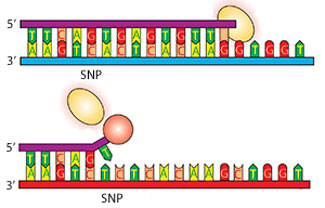| Oct 24, 2011 |
Gold nanoparticles speed up discovery of the genetic patterns responsible for disease
|
|
(Nanowerk News) Many illnesses are now being linked to particular patterns of mutations in an individual's DNA. However, the search for these patterns, known as haplotypes, is generally a slow and painstaking process. Yongyong Shi and colleagues from Shanghai Jiao Tong University in China have now shown how gold nanoparticles can be used to turn haplotyping into a high-throughput process ("Gold nanoparticles for high-throughput genotyping of long-range haplotypes").
|
|
Haplotyping has posed geneticists with a challenge because the individual mutations that make up a particular pattern can be tiny. One of the most common types of genetic variation is a single-nucleotide polymorphism (SNP), representing a variation on just one DNA base pair. Shi and his colleagues have shown how the technique used to detect SNPs can be improved to such an extent that multiple SNPs can be detected on a single strand of DNA, allowing for rapid haplotyping.
|
 |
| Gold nanoparticles (red sphere) prevents DNA polymerase (yellow oval) from attaching to DNA during AS-PCR. (© 2011 NPG)
|
|
The technique used by the researchers, called allele-specific polymerase chain reaction (AS-PCR), involves amplifying the DNA of interest for sequencing through the attachment of short 'primer' strands to the sample DNA and then extending this strand base-by-base using an enzyme called DNA polymerase. AS-PCR primers are designed so that they end at the SNP of interest. If the primer sequence matches the SNP, amplification takes place as normal. But if there is a mutation at the SNP, the primer doesn't fully attach, inhibiting amplification.
|
|
By adding gold nanoparticles to the mixture, Shi and his co-workers found that the amplification of the mismatched strand is suppressed much more effectively, making such mismatches considerably easier to detect. The finding was a surprise, Shi says. Previous research had shown that nanogold can modestly improve the selectivity of PCR reactions. "We were quite amazed by its fantastic performance, especially for long-range AS-PCR, which forms the basis for our haplotyping method," he says.
|
|
The next step for the team will be to pin down exactly how the gold nanoparticles enhance AS-PCR so effectively. The researchers have already shown that the nanoparticles bind preferably to the mismatched, single-stranded primer (see image). "We suspect that the nanoparticles might work by sequestering the mismatched primer-template, preventing it from binding with DNA polymerases," he says.
|

